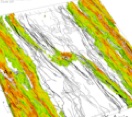
Transitional disks are disks with gaps and holes, first discovered by IRAS and recently confirmed with both Spitzer and submm interferometry. They could be signpost of young giant planets in disks which are capable of opening gaps. We investigate gap opening by multiple planets and found it still has difficulties in explaining observations. This motivates us to study gas and dust decoupling in these disks.

Whenever gaps are opened, particles will be trapped at the outer edge of the gap due to the gas drag. This accumulation effect depends on particle sizes, disk turbulence, and gap depth. Dust and gas are thus decoupled at the gap edge, which has important implications for sub-millimeter observations.
When young planets are born in protoplanetary disks, they will interact with the disk causing migration or gap opening. However, the migration is stochastic due to the MRI turbulence and the gap opening process depends on the disk magnetic fields.

Planet can excite buoyancy waves in 3-D disks, similar to wind blowing over a mountain. The excitation of buoyancy waves can lead to a significant amount of angular momentum exchange between the planet and the disk.

